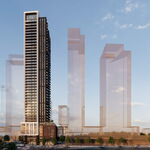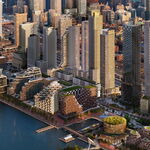EnviroTO
Senior Member
Yes, it tells you it is along Eglinton West which is just under a 19km stretch of road that begins at Etobicoke Creek (beyond which the street is Eglinton East) to Yonge (beyond which the street is Eglinton East). With the Science Center moving perhaps the station could be named Eglinton Central East to match the naming convention. Does it tell you it is on Eglinton West? Sort of, I mean that could also be the name of the neighbourhood because there isn't a standard... Osgoode isn't on Osgoode street. If you do decide that yes Eglinton West is on Eglinton St West you that still doesn't tell you that you need to go there because if you are going to 174 Eglinton St West, Eglinton Station is closer despite the "West" and for I'm not doing the math but I would hazard a guess that less than 1% of the addresses people might go to in this city do not have stations named after their streets (e.g. Marlee), but far more streets do belong to neighbourhoods. The naming of stations to match street names misses the point that people do not navigate subways that way. People don't hang a right on Eglinton, they get off at Station Name and transfer to bus route. The more clear and unambiguous the Station Name the better.I highly disagree. 'Eglinton West' tells me the station is somewhere along Eglinton Avenue West, and makes it easy to select from a list of stations when I am researching my transit connections if I know my destination is along Eglinton Avenue West, for example. 'Cedarvale' doesn't tell me anything - it doesn't make the station jump out, and neighbourhood names are fickle - what was a current name in the 1990s doesn't have to be current now.
I don't know how you can say "by this logic" when if you are following at all that is the opposite to what I am saying. I'm saying it should be named after a Neighbourhood or a Place Name that the station is closer to than any other station. Sometimes those neighbourhoods do have a street name in them, so they should use that, but most have neighbourhood names that don't have street names. St.Clair Station is in the neighbourhoods best described as Yonge - St.Clair or Deer Park, so those names are unambiguous. Nobody living around St Clair West says they live in the St Clair West neighbourhood, they would likely say they live in Forest Hill South. Why would it be acceptable to have a station named Forest Hill and Forest Hill South? Because those places are actually near each other whereas if you wrongly head to Lawrence, Lawrence West, and Lawrence East you can be in a completely different place far away from where you want to go. Wayfinding should work a bit like taxonomy... start at the high level then work your way down Metro (airports, national rail) -> City (RER) -> Neighbourhood (Metro) -> Street (Bus) -> Street Number (Sidewalk) -> Unit (Elevator/Hallway). If you are focusing on street too early you could be at Dundas East in Mississauga.By this logic, why have any geographical names at all? You can make Eglinton Midtown, Davisville Midtown Middle, St. Clair Midtown South, etc.
So station names with the latitude and longitude perhaps, and directions with compass co-ordinates to help the map nerds. I just don't think there are many people who honestly navigate that way and as we add lines that are not straight like the GO lines once they are running RER like service, or the Ontario Line to the maps, people aren't going to navigate with compass directions. I can't imagine anyone in Tokyo, London, or Paris navigating by north, south, east, and west.Speak for yourself. I'm a map nerd and I'm always thinking in directions. In the time I can figure out that going eastward means going to Kennedy, or going westward means I'm going towards Kipling, I could've figured out that I need a westbound or eastbound train about 5 times over. This doesn't mean that we shouldn't have signs identifying the terminus stations, but good wayfinding needs to accept that different people think differently of the world, and the information you personally gravitate to does not have to be the information I gravitate to.
Surface routes are a different ball game. On the surface you have a sense of direction, you are going places you see, you follow streets, you stop at streets, and routes are more dynamic.It is even worse on the surface network, which can change at the drop of a hat. "Westbound streetcars" at a downtown subway station is infinitely more useful than specifying the destination the vehicle is going to, since, as we've seen in the last 4 years, where that destination is changes at least once a month.
I agree Metrolinx sucks too. Metrolinx hasn't renamed other stations like it has Cedarvale unfortunately. They started off with a plan and ran out of gas, then new politics got involved, and now you have Durham College Oshawa GO.Moreover, if we accept your argument that stations should be named for places, Metrolinx fails horrifically at this too. Eglinton GO is miles from Eglinton station. There are 6 GO stations in Scarborough, one of which is named "Scarborough", which seems to imply to the ignorant traveller that it is the station for Scarborough.
It does, that is why I think they need to continue with station renaming. I'm not sure why someone wanting to go to the beach at Rouge Hill would find themselves at St Clair and Midland though... there is a Rouge Hill station in the West Rouge neighbourhood. It seems like a good station name... not the Lawrence East East station or whatever a street focused naming would have called it. Scarborough GO, Bloor GO, and Eglinton GO are also offenders.What would you say to a tourist who wants to go to the beach at Rouge Hill and finds themselves at St. Clair and Midland? What about Scarborough Centre subway station, which will be present on the SSE? That doesn't provide a confusing experience for the traveller?
What if you are going from the Ontario Science Centre to Pape, then you are travelling in a generally southbound direction. You can't change the signage based on where the person might get off.That's not true. If one is travelling from the Ontario Science Centre to the Exhibition, they are still travelling in a generally westbound direction. All you need for directions on wayfinding is to give a general overview of the direction the person is going, you don't have to account for every squiggle and bend in the line.
I'm not conflating different things. I'm saying metro/subway and bus is different, that metro/subway serves a different purpose than bus and therefore station names and stop names should talk about different scales.You are needlessly conflating different things here. Despite what transit influencers would have you believe, local city systems and regional transit IS different. GO is not a local service, stopping at every other street. Durham College Oshawa GO is, as I stated above, a loathsome name that runs counter to all of your principles about wayfinding, being that Durham College is nowhere near. Oshawa GO was a good name, it is global practice to name intercity train stations for the towns that they serve (or the neighbourhoods of the town, if there is more than one station in the city, which is not the case in Oshawa).
Who is talking about places 80km away, the distance between 1900 Bloor St Mississauga, and 4357 Bloor St W Toronto is 650m, and 4357 Bloor West is East of Mississauga. For people travelling through the GTA, Bloor isn't a place.To which I would say that what goes on outside of Toronto is not the concern of Torontonians. Again, conflating regional and local transit is harmful. Wayfinding should be set up for the benefit of the people travelling locally, it should not be pandering to a city 80 km away that happens to have the same named street.
I'm not saying it is inaccurate, I'm saying it says more than it needs to be. You could write on the sign that this is not the right platform for the University Line also known as the Spadina Line, that you are currently on sublevel 3, that the station the train is arriving from is St.Andrew, you could write on the sign that you should take this train to Eaton Centre and Yonge-Bloor because those are popular spots, you could also write on the sign that there is no smoking on the TTC, no urinating or defecating on the train, and that the current CEO is Rick Leary. All those things are entirely accurate.I see nothing wrong with the sign you listed. It gives all the information about the service, in whatever language the traveller requires it. They know it's going north, they know it's going to Finch, they know the line runs along Yonge Street, and they know the next station is King.
Last edited:




